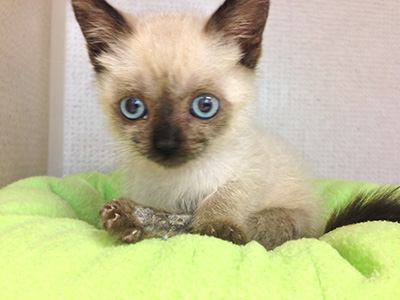
I met Pye several weeks ago when she was brought to the shelter where I work. She was one of the cutest kittens I have ever seen, and I see a lot of kittens at my work. She had me at “hello,” when she rolled on her back and stared at me with her huge, blue eyes. Unfortunately, during my examination, I realized that she was unable to use her rear legs. This didn’t seem to stop her, as she dragged herself around my exam room. In addition, she had no anal tone and a huge belly that made her look like an engorged tick.
Diagnosing paralysis in Pye
We took radiographs to check for fractures and other spinal injuries. The radiographs confirmed my suspicion. Although no fractures were visible, Pye had a colon full of fecal material, suggesting spinal trauma preventing her from defecating normally. Spinal trauma would also explain her paralyzed hind legs. Even though she was adorable, I was afraid it would not be easy to find a home for a kitten unable walk or control her bowels. To make matters worse, we were in the thick of kitten season and the shelter was overflowing with healthy kittens in need of homes. Click here for 5 Reasons to adopt from a shelter.
Treating Pye with help from an orthopedic surgeon
Looking into her deep blue eyes, I wasn’t prepared to give-up on Pye. Despite her medical condition, Pye purred non-stop and was as sweet as could be. So I contacted one of the best veterinary orthopedic surgeons in town, who also happens to love cats and has about 15 cats of her own, to get her opinion. Luckily, she felt that because Pye was so young and had no obvious fractures, she might recover with time. So we continued to treat Pye and hoped she would improve while we waited for a rescue. Within three days, she still had no anal tone and could not fully empty her bowels without the help of enemas, BUT she was starting to use her back legs.
Her improvement was great news. Not only because it meant she might recover fully, but also because a rescue had agreed to take her if she improved and could urinate on her own. I excitedly dropped her off for a recheck with the orthopedic surgeon who was arranging her foster home. While saying goodbye was hard, I knew she was in good hands.
Pye, after treatment
Now, two weeks later, she is off almost all medications, is defecating on her own, has anal tone and is walking better. Though not perfect yet, she continues to improve and hopefully will be off all medications soon. Not surprisingly, her foster mom has fallen in love with her and may keep her in the end.
Knowing that Pye is doing so well not only warms my soul, but also reminds me to never quit or give up hope. Working together, people can do so much good.
 This story was selected for our series: “Heartwarming Stories for Your Holiday.”
This story was selected for our series: “Heartwarming Stories for Your Holiday.”
If you have any questions or concerns, you should always visit or call your veterinarian -- they are your best resource to ensure the health and well-being of your pets.
